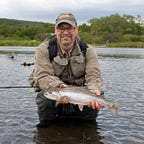Wildlife viewing around Alaska’s biggest city gains fresh dimension once the snow flies.
By Ken Marsh
Lit by morning stars and a bright gibbous moon, the first tracks leaped out within a few steps of the trailhead. A short-tailed weasel, or ermine as they’re called when their coats turn snow-white for winter, had bounced back and forth across the trail, hunting. Prospects seemed good for the tiny predator (a large ermine might weigh 7 ounces) as here and there the tracks of voles and shrews, the ermine’s prey, laced the snow in stitch-like patterns.
I’d arrived at the Glen Alps trailhead early, keen on finding moose to photograph, but the day had immediately promised more. A light snowfall the evening before had yielded to clearing skies and falling temperatures; tracking conditions were perfect and I was eager to read the news.
In wintertime, Alaska’s snow-covered hills and frozen muskegs are pages upon which stories are written. Creatures from mice to moose leave bylines on drifts and dustings, their dispatches and updates evident in each flurry’s wake. These tales can be fascinating and revealing. They can also lead to the wildlife we hope to watch and photograph.
I continued on, snowshoe bindings squeaking softly, the temperature a pleasant 10 below zero. Dawn waited less than an hour away.
Passing through a spruce thicket I watched the moonlit breaks for snowshoe hares. Their namesake hind feet, long and broad like my own snowshoes, had left distinctive prints in the newly fallen powder. Like ermine, hares’ fur turns from brown in summer to white in winter. The animals blend well into their environments and can seem almost invisible.
I followed the moon into the Chugach Range foothills until the sky brightened and sunbeams spilled over the crags. That’s when a set of cloven hoof prints appeared on the trail. Comparable in size to the tracks of a draft horse, the prints sunk like postholes into the snow. I paused to pull the camera from my pack and check its settings. The moose could not be far.
Moose are common in Southcentral Alaska and can be seen year round from the mountains backing Anchorage to the city’s greenbelts, parks and neighborhoods. I likely could have found moose by simply driving through Kincaid Park or along Point Woronzof near Ted Stevens Anchorage International Airport. But the adventure is in the hunt, and for me on this early winter day that meant tracking the big deer in Chugach State Park’s roadless fringes.
Rounding a turn in the trail I glanced up from the hoof prints and halted. Not 30 yards away, a large bull moose weighing perhaps half a ton faced me, its head haloed by walnut-colored antlers 6 feet wide.
For a moment the entire world seemed to stop. I didn’t move, didn’t breathe. Steam rose from the bull’s nostrils, floating up between those antlers and the backdrop of mountaintops and early-morning sky they cradled.
Gradually, the situation fell into focus. The bull was bedded down, watching me curiously. It was not alarmed.
Even so, I was close enough. Moose typically are gentle giants, no more aggressive than their much smaller southern whitetail and mule deer cousins. When approached too closely, though, they may become frightened and lash out. Better to keep a safe distance and let your telephoto lens close the gap.
Slowly, I lifted my camera, framed the bull in my viewfinder, and released the shutter.
Winter wildlife viewing around Anchorage isn’t limited to moose. Dall sheep can be found about a 25-minute drive south of the city at Windy Corner. Located at Milepost 106 of the Seward Highway along scenic Turnagain Arm, the white sheep are drawn year-round by a natural mineral lick. Windy Corner is unique, according to the Alaska Department of Fish and Game — no other place in the world offers roadside Dall sheep viewing at sea level.
Bald eagles also winter around Anchorage as do a variety of smaller birds ranging from chickadees, red-breasted nuthatches, and Bohemian waxwings to spruce grouse and all three species of North American ptarmigan — willow, rock and white-tailed. And while area black and brown bears normally sleep away the snowy months, lucky wildlife viewers may be treated to glimpses of wildlife as magnificent as lynx, wolves, and even wolverine.
I started out of the hills that evening, delighted to have found that bull moose and, later, two others a mile down the valley. Already the sun was sinking into Cook Inlet and in the gathering dusk Anchorage could be seen far below, its lights winking on for the night. For the moment, it seemed I had one foot planted in wilderness and the other in the city, while in between I enjoyed winter, wildlife, and the best of both worlds.
###
Where the Wild Things Are
Chugach State Park
Several Chugach State Park trailheads are within a 20-minute drive of downtown Anchorage. Popular trailheads include Prospect Heights, O’Malley, Upper Huffman, and Glen Alps; access from Hillside Drive at Upper Huffman or Upper O’Malley roads.
· Look for moose, lynx, snowshoe hares and ptarmigan. Though rarely seen, wolf and wolverine are also present.
Windy Corner
Located at Milepost 106 along the Seward Highway south of Anchorage.
· Look for Dall sheep on cliffs and rocks next to and above the highway. Also, occasional moose, bald and golden eagles, snowshoe hares, coyotes, lynx.
Kincaid Park
Located in west Anchorage at the end of Raspberry Road, 1,400-acre Kincaid Park can be accessed from numerous Nordic skiing and multi-use trails.
· Look for moose, lynx, snowshoe hares, goshawk, spruce grouse
Point Woronzof
Travel west on Northern Lights Boulevard and continue past the airport.
· Look for moose, snowshoe hares, bald eagles.
For more about wildlife viewingthroughout Alaska in all seasons, visit http://www.adfg.alaska.gov/index.cfm?adfg=viewing.main
###
